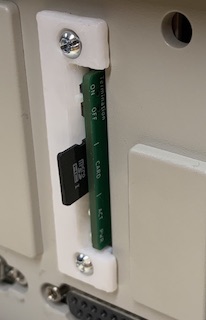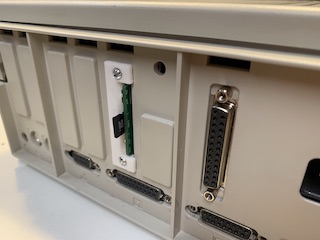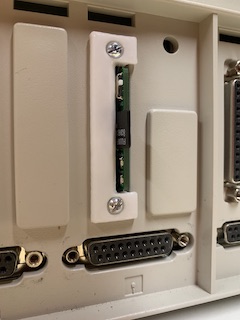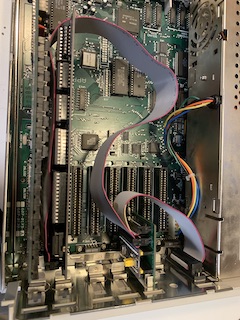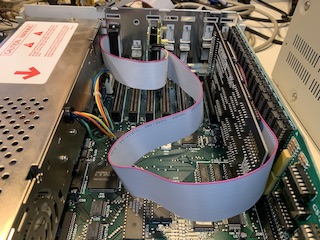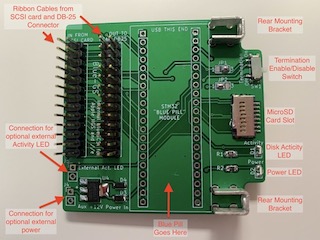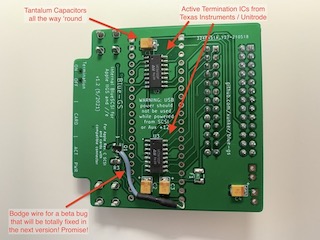| assembly | ||
| gerber/v1.2 | ||
| images | ||
| installation | ||
| kicad | ||
| schematics | ||
| slot_cover | ||
| .gitignore | ||
| CHANGES.md | ||
| LICENSE.md | ||
| POWERING_BLUE-GS.md | ||
| README.md | ||
| TERMINATION.md | ||
BlueGS: Internal BlueSCSI for Apple IIgs and Enhanced //e
https://github.com/xunker/blue-gs
- BlueGS: Internal BlueSCSI for Apple IIgs and Enhanced //e
- About
- How it works
- Features
- Compatible SCSI cards
- Performance
- Assembly
- Installation
- Schematics
- EDA/Kicad and Gerber Files
- Credits
- License
About
BlueGS is the internal hard drive your Apple IIgs and //e always craved.
Using the BlueSCSI SCSI drive emulator and your compatible SCSI card, you have a fully internal hard drive with accessible microSD slot while still keeping your DB-25 connector free for other peripherals.
How it works
BlueGS connects between your SCSI card and its external DB-25 connector to give you a seamless installation. The BlueGS module itself mounts in a free DB-25 connector cutout in the rear of your IIgs or Enhanced //e.
Features
- Gives your Apple IIgs or //e an internal, cable-free hard drive
- Can be powered from SCSI termination power only (if present)
- "Termination Power" mod is not required (when powered from the IIgs internal fan connector)
- Can provide termination power to the SCSI bus (when powered from the IIgs internal fan connector)
- Built-in termination that is controlled with a single switch
- TI/Unitrode termination ICs instead of passive termination, reduces power consumption by over 2/3rds
- Connection for external drive activity LED
Compatible SCSI cards
Tested:
- GGLabs A2SCSI - a clone of the Apple Rev C SCSI card
Untested, but expected to be compatible:
- Apple Rev C SCSI and clones
- Apple High-Speed SCSI ("Sandwich II")
Unknown, but likely compatible:
- Ramfast SCSI
- Any SCSI card that uses has the same IDC-26/DB-25 pinout as the Apple Rev C SCSI
If you have an SCSI card with an IDC-26/DB-25 connector that has not been tested and would be willing to test your card with BlueGS, please contact us to arrange to have a test unit sent to you.
How do I know if my card provides "termination power"? What if it doesn't?
Running BlueGS from "termination power" makes installation much easier, but not all SCSI cards have it. For more details, please check out the notes on Powering BlueGS.
Performance
Using BenchmarkD with Apple IIgs (ROM 1, "Fast" speed), GS-RAM Plus w/ 2MB, GGLabs A2SCSI card.
- Read
- File: 52 KB/s
- Block-by-block: 36 KB/s
- With 64K buffer: 79 KB/s
- Write (File): 37 KB/s
Assembly
If you purchased BlueGS as a self-assemble kit or are using your own PCBs, please follow the instructions in the "assembly" directory.
If your BlueGS was purchased fully-assembled, please move on to the "Installation" section.
Installation
Installation guides can be found in the "installation" directory.
Schematics
V1.3 Schematic (non-final, subject to change)
EDA/Kicad and Gerber Files
Kicad of current design can be found in kicad directory.
Gerber files for v1.2 can be found in the gerbers/v1.2 directory. Note: v1.2 has bugs and it not recommended for general use. V1.3 will be available shortly which will address these bugs.
Credits
This project would not be possible without the work done by ztto, Tambo, Eric Helgeson, and many others.
The "Blue Pill" footprint was originally created by Yet-Another-Average-Joe.
Symbol and footprint for Molex 105162-0001 MicroSD slot created by SnapEDA user HMantz.
External LED driver circuit credit to @akuker on Open Retro SCSI Discord.
License
See LICENSE.md.
